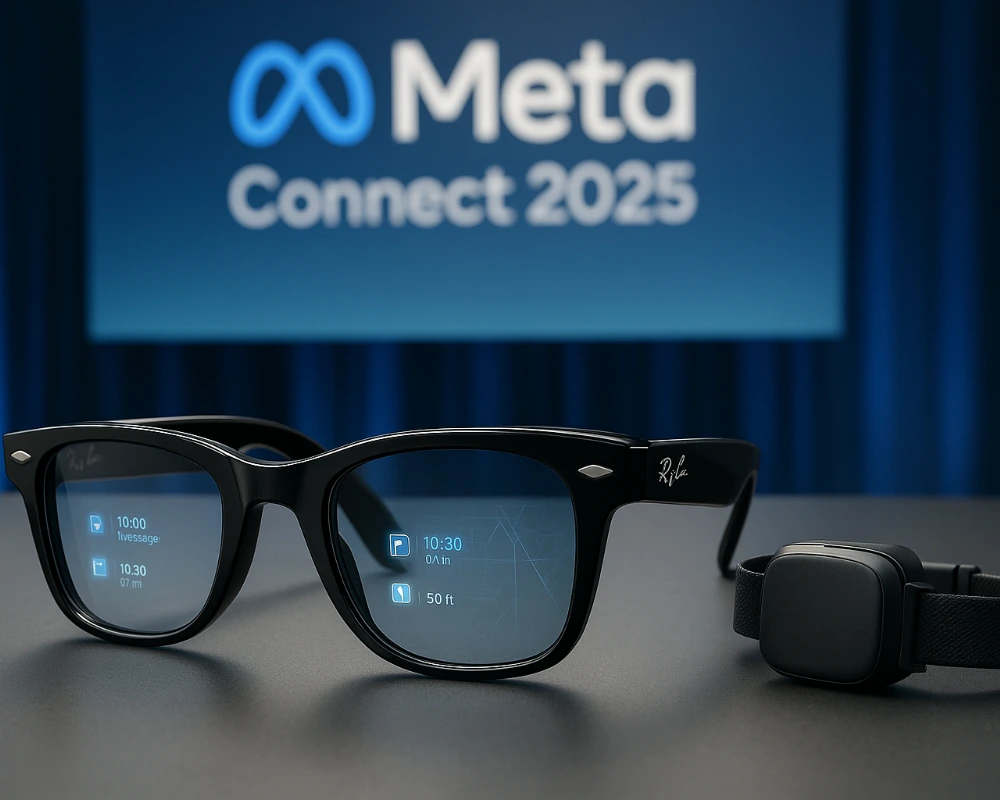Meta is betting big on the idea that the future of computing won’t sit in your pocket or on your desk, but on your face. At its Connect 2025 event, Mark Zuckerberg unveiled the new Ray-Ban Display smart glasses and a companion Neural Band wrist device, priced from $799 and arriving Sept 30 in select markets.
What’s new
These glasses look like regular Ray-Bans, but inside the right lens is a discreet screen that can show notifications, maps, messages, and even live captions. Instead of fumbling with buttons or voice commands, users control them with the Neural Band — a wristband that reads subtle electrical signals from your hand and fingers.
Why it matters
This is Meta’s most ambitious step yet to make augmented reality feel natural. Earlier Ray-Ban smart glasses focused on cameras and audio. Now, with a built-in display and neural interface, Meta is pitching eyewear as the ideal form factor for AI: stylish, everyday, and always on.
Zuckerberg’s pitch
Calling the glasses a milestone in a “decade-long effort,” Zuckerberg described them as a path to “personal superintelligence” — tools that can extend memory, senses, and communication while letting people stay present in the real world.
Market reaction
Analysts say the design could appeal to more people than bulky VR headsets. But at $799, Meta will need to convince buyers there’s enough everyday usefulness to justify the cost. The U.S. gets them first, with a wider rollout planned for 2026.
The bigger picture
- Short term: Meta strengthens its position in AI wearables and deepens partnerships with retailers.
- Long term: Expansion into more countries will bring competition with other Big Tech AR efforts — and likely more scrutiny over privacy, AI, and safety.
FAQs on Meta’s Ray-Ban Display Glasses
1. What are Meta’s Ray-Ban Display glasses?
They are smart glasses with a small display built into the right lens, capable of showing notifications, maps, messages, and live captions.
2. How do you control the glasses?
The glasses work with the Neural Band wrist device, which uses EMG (electromyography) to read subtle finger and hand signals for control.
3. What is the price of Ray-Ban Display glasses?
The glasses start at $799, making them a premium wearable product.
4. When will they be available?
Sales begin on September 30, 2025 in select U.S. markets. A broader international rollout is planned for 2026.
5. How are these different from earlier Ray-Ban smart glasses?
Earlier versions focused mainly on cameras and audio. The new Display model adds an in-lens screen and gesture-based control through the Neural Band.
6. Are these glasses AR or VR devices?
They aren’t full AR or VR headsets. Instead, they’re lightweight glasses with a built-in display meant for notifications and AI features in daily life.
7. Who is Meta targeting with these glasses?
Meta is aiming for everyday users who want AI assistance in a familiar form factor like sunglasses, rather than bulky headsets.
8. Will the glasses be available outside the U.S.?
Yes, Meta has announced plans to expand to more countries in 2026, though no specific markets have been confirmed yet.
9. Are there privacy concerns?
As with all AI and wearable tech, experts say regulatory scrutiny is likely, especially regarding data privacy, AI use, and safety.
10. What did Mark Zuckerberg say about them?
He called the glasses a milestone toward “personal superintelligence,” describing them as tools to enhance communication, memory, and senses while keeping people present in the moment.







Leave a Reply